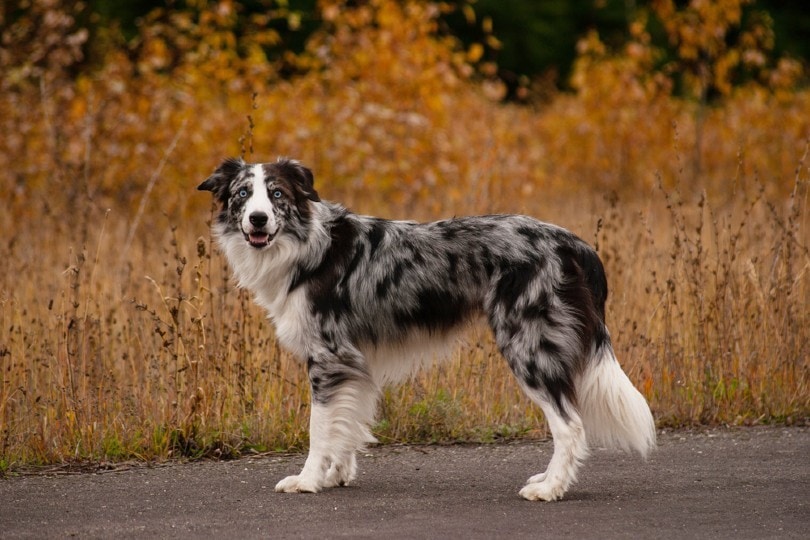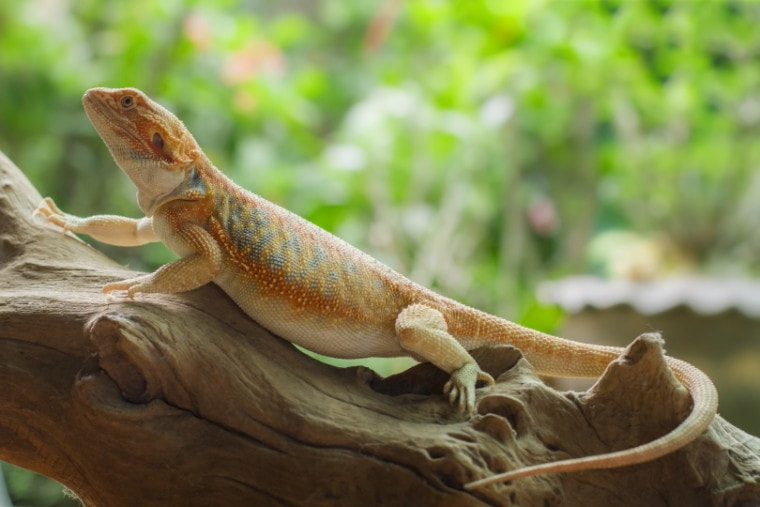
Leatherback Bearded Dragons are Beardies with a unique morph. Whereas most Beardies have spikes on their backs, this morph causes Leatherbacks to have a smooth back.
Much like other Bearded Dragons, Leatherback Bearded Dragons make great pets. They are low maintenance and not aggressive towards humans. To find out facts, information, and care requirements for these Beardies, read on.
Quick Facts about Leatherback Bearded Dragons
| Species Name: | Pogona |
| Common Name: | Leatherback Bearded Dragon |
| Care Level: | Beginner |
| Lifespan: | 7–12 years |
| Adult Size: | 15–20 inches |
| Diet: | Insects and leafy vegetables |
| Minimum Tank Size: | 4 x 2 x 2 feet |
| Temperature & Humidity | Cool side of the enclosure: 80 degrees Fahrenheit Basking Area: 95–104 degrees Fahrenheit Humidity: 30%–40% |
Do Leatherback Bearded Dragon Make Good Pets?
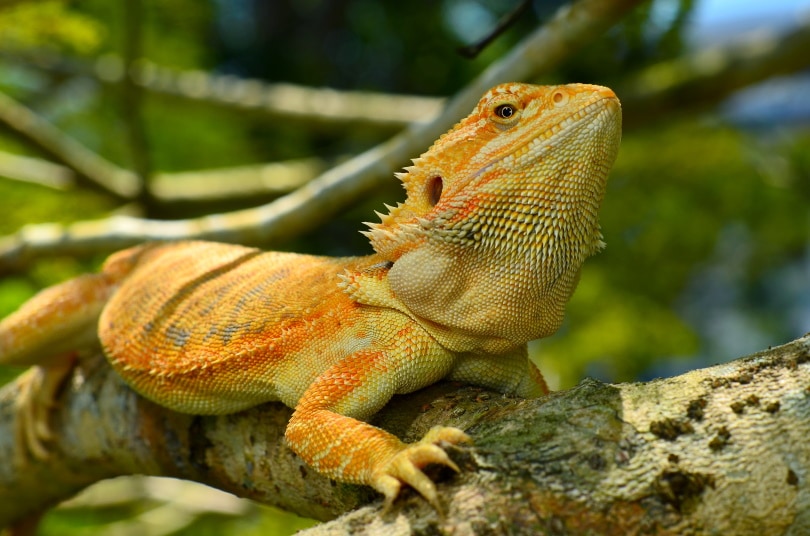
Leatherback Bearded Dragons make good pets because they are stunning, docile, and pretty suited for handling. When compared to other reptiles, Leatherback Bearded Dragons are suited to humans and aren’t aggressive.
Appearance
Leatherback Bearded Dragons look different from other beardie varieties because they have a unique morph that causes them to have a smooth back, but their heads and sides still have spikes.
Because of the lack of spikes, it is common for Leatherback Bearded Dragons to appear more vivid in their coloration, even though the colors themselves are not anymore vivid. The colors are more visible since there are no spikes in the way.
Leatherback Bearded Dragons can come in many colors, including red, orange, citrus and more.
How to Take Care of Leatherback Bearded Dragon
Taking care of any Bearded Dragon requires extensive knowledge about the lighting and temperature, and the same is true of Leatherback Bearded Dragons. Here are the most important things to know when taking care of one of these delicate creatures.
Habitat, Tank Conditions & Setup

Leatherback Bearded Dragons are relatively easy to take care of, assuming that you set up its habitat properly.
Tank
To begin, you want to select a tank that comes with glass walls and a screen top. At the very minimum, the enclosure should be 4 x 2 x 2 feet. However, the bigger the better. Inside the tank, you want to replicate the Bearded Dragon’s natural environment. Place rocks, branches, hiding spots, and shade within the enclosure.
You want to keep this enclosure clean too. At the very minimum, make sure to remove any uneaten food. We recommend spot cleaning daily and deep cleaning monthly
Lighting
Because Bearded Dragons are cold blooded, they require extensive lighting. These lizards are diurnal, meaning they need 12 hours of daylight, as well as 12 hours of darkness.
Select an ultraviolet light to prevent against illnesses common in Bearded Dragons, such as metabolic bone disease. Replace the UV bulb every 6 to 12 months. Additionally, provide a 40 to 75 watt infrared bulb. This bullet will be used for basking. Place this basking bulb on one side of the enclosure to create a basking side.
Heating (Temperature & Humidity)

As for heating, you need to provide a temperature gradient within the enclosure. The basking side of the enclosure should be between 95 and 105 degrees Fahrenheit. The remainder of the tank should be around 80 degrees during the day. Reduce the temperature slightly at night.
You need to keep a thermometer on both sides of the enclosure to ensure that both the cool and basking side are the proper temperature. If you notice that your Bearded Dragon is opening its mouth, almost as though it were smiling, the tank is likely too hot.
Humidity is an important aspect of heating. Keep the humidity between 30% and 40%. Maintain this humidity by misting the entire enclosure every 42 hours and placing a small water bowl inside the enclosure. If you need to increase humidity, you can place a heating pad underneath the bowl of water.
Substrate
The last habitat factor to remember is the substrate. We recommend using newspapers or paper towels because they are safe, soft, and will not hurt the Bearded Dragon’s gastrointestinal tract in the case that it should swallow it.
| Tank Recommendations | |
| Tank Type | Glass vivarium |
| Lighting | UVB, infrared |
| Heating | Lights, heating pads if necessary |
| Best Substrate | Newspaper or paper towel |
Feeding Your Leatherback Bearded Dragon

Whenever it’s time to feed your Leatherback Bearded Dragon, you want to replicate its natural diet as best as possible. In the wild, these animals naturally eat leafy greens, insects, and some smaller lizards. In captivity, it is best to feed a diet primarily made of leafy greens and some insects.
Hatchlings, which are Leatherback Bearded Dragons under two months old, need to eat two to three times a day. Meanwhile, juveniles and adult Bearded Dragon should be fed daily.
Make sure to provide calcium and vitamin D3 supplements too. These supplements help prevent common diseases found in Leatherback Bearded Dragons, such as metabolic bone disease.
| Diet Summary | |
| Vegetables | 70% of diet lLafy greens, squash, carrots |
| Insects | 30% of diet Crickets, mealworms |
| Supplements Required | Calcium, vitamin D3 |
Keeping Your Leatherback Bearded Dragon Healthy
The most important parts of keeping your Leatherback Bearded Dragon healthy is to provide the proper environment and diet.
Making sure that there is the proper lighting, temperature, and humidity can go a long way for promoting your Leatherback Bearded Dragon’s health. Similarly, providing a balanced diet of vegetables and insects, as well as vitamin supplements, ensures further health and wellbeing.
Common Health Issues
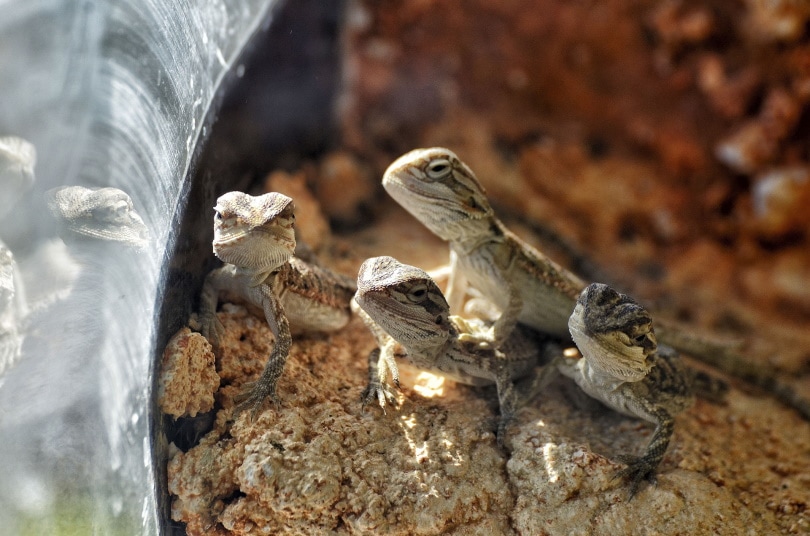
The reason why Bearded Dragons require such extensive lighting, temperature, and humidity requirements is because they are prone to metabolic bone disease. This disease is often caused by a calcium deficiency or lack of UV lighting.
Lifespan
Leatherback Bearded Dragons are considered pretty healthy reptiles. In captivity, they can live between 7 and 12 years.
Most commonly, premature death is due to an issue in their enclosure or diet. Making sure you follow the instructions in this guide carefully can help to ensure that your Bearded Dragon lives as long as possible.
Breeding
When it comes to breeding, the male will attempt to court the female by darkening its throat and circulating around the female. If the female accepts, she will flatten out her body. At that point, the male will begin copulating with the female and bite her neck. This courting and breeding phase happens in spring and early summer. In the wild, this often happens after brumation, which is why many breeders force their reptiles into brumation before breeding them.
After copulation, a nest box must be offered since these animals bury their eggs. Create a nest box with 10 inches of sand or soil. The females will lay three different clutches of around 35 eggs per clutch.
Once the female lays the eggs, remove the nest box and put it inside an incubator. The eggs will hatch in three to four weeks. Separate the Bearded Dragons as soon as they hatch.
Are Leatherback Bearded Dragon Friendly? Our Handling Advice
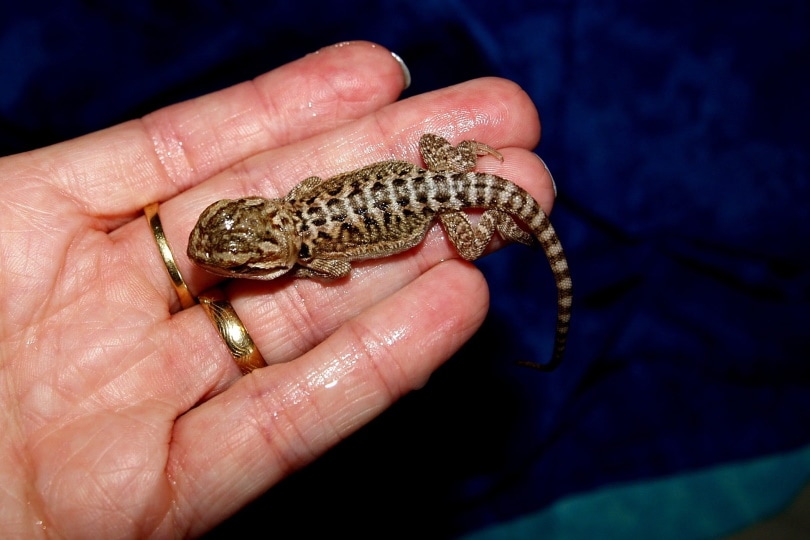
Leatherback Bearded Dragons are considered friendly and much calmer around humans than other reptiles. That being said, these animals are aggressive to one another. It is for this reason that you want to keep Bearded Dragons alone.
Still, beardies are much more friendly and suited for human handling than other reptiles. Always make sure to wash your hands before and after handling the animal. Leatherback Bearded Dragons are known to run a bit when you first try to handle them, but they get used to it and don’t become aggressive.
As you are holding these animals, make sure to hold them flat. Do not cradle them. This is the more natural position that their body should be placed in. We recommend leaving the beardie alone for the first week you bring it home simply so that it can adjust to its new habitat.
Shedding & Brumation: What to Expect
Although it is not guaranteed, some Bearded Dragons go through a brumation period. During this time, the Bearded Dragon will eat less and sleep anywhere from 2 weeks to 4 months. Many breeders force their beardies into brumation before sexing.
It is important to note that many Bearded Dragons never go through a brumation period in captivity. For this reason, don’t be shocked if the Bearded Dragon never goes through this phase, but don’t be scared if it does either.
How Much Do Leatherback Bearded Dragons Cost?
Leatherback Bearded Dragons can cost anywhere from $100 to $500. This puts them right in the middle of the pack in terms of Bearded Dragon morph price. The exact cost will depend on where you live, the color of the beardie, and the breeder you select.
Care Guide Summary

Final Thoughts
Leatherback Bearded Dragons are a super fun, attractive, and unique Bearded Dragon morph. Just like other Bearded Dragons, these animals are easy to care for, but they are more vibrant than many other morphs. So long as you provide the proper environment and diet, your Leatherback Bearded Dragon should live a healthy life.
Featured Image Credit: Worraket, Shutterstock



